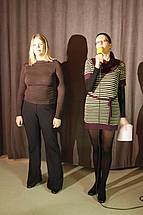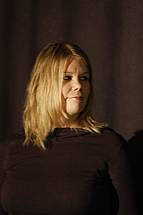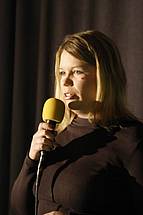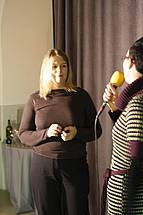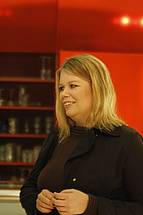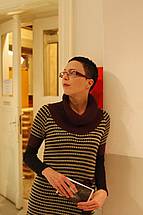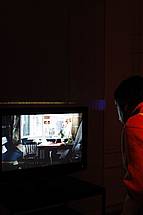
| News | Events | Archive | About us | Partners | Projects | For the media | Contacts |
Eija-Liisa Ahtila – The Present
Friday 3/10/2008 at 8 pm, Kibela - the opening of the exhibition of a Finnish artist, a renowned creator in the field of contemporary video and art film.
Eija-Liisa Ahtila – The Present
Eija Liisa Ahtila creates within the field where the margin between video in still-life loops and the narrative film is blurred. The intersection of her art is analogue film narrative set in hypertextual environment, thus creating digital reality based on a traditional medium. She has been presented at all prestigious events, such as the Venice Biennial, Documenta in Kassel, Tate Gallery in London, Kiasma in Helsinki etc. Her works are on display in the majority of prominent world museums, galleries and collections from Finnish contemporary art museums to the Museum of Modern Art in New York. She belongs to the very top of contemporary visual art. This is the first presentation of her work in Slovenia.
Eija-Liisa Ahtila was born in Hameenlinna, Finland in 1959. She attended the HelsinkiUniversity between 1980 and 1985 and then the London College of Printing, School of Management, Film and Video Department in London in1990-91. In 1994-95 she specialized at the American Film Institute, Advanced Technology Program in Los Angeles. At the moment, Eija-LiisaAhtila is studying for a doctorate at the Academy of Fine Arts,Helsinki.
Through her work she researches experimental narrative modes and techniques, such as the relation between short films and commercials, the technique of broken screens and narrative possibilities of multi-screen installations. In 1999 Eija-Liisa Ahtila represented the Finnish pavilion at the Venice Biennial. She held individual exhibitions in Fridericianum Museum in Kassel, in Kunsthaus museum in Glarus and the Berlin Neue Galerie. Her films were shown at more than 40 international film festivals around the world and several TV channels in Europe and Australia. She lives and work in Helsinki. Her works are created in cooperation with Crystal Eye, a film production company owned by her husband Ilppo Pohjola.
At the beginning, the conceptual content of Ahtila's art was motivated by art philosophy, by a critique of art institutions and by feminism. The focus of her investigations was the construction of the image, language, narrative and space. After 1990 she went even more deeply into themes surrounding individual identity and the limit of the self and body in relation to the other.
According to Eija-Liisa Ahtila, what interests her in films and photos above all is the story. She calls her films “human dramas”. They deal, as do many of her other works, with human relationships, sexuality, the difficulty of communication, individual identity, its formation and disintegration. The stories Ahtila tells through her films and photos are based on research, on real and fictional events, on the experiences and memories of the artist herself, of those she knows, or of complete strangers.
In one of her last videos Consolation service (awarded at the Venice Biennial in 1999) Ahtila also deconstructs the formation of the narrative and cinematic illusion: as though in a straight documentary film ('cinema verite'), both the narrator and camera are shown openly. The illusion of fiction is thu shattered, made visible. The use of a hand-held shaking camera reminds o the group Dogma 95 led by Lars Von Trier. (Paolo Curti/Annamaria Gambuzzi & Co.)
Eija-Liisa Ahtila’s three-screen video installation The House, 2002, raises numerous questions. When you see a toy car ride on a living-room wall, a cow walk into an ordinary house, and a woman fly across treetops, it is easy to think of fairy tales. The fantasy of flying appeals to a deeply felt desire for freedom from conventional limitations like gravity, and seeing miracles in a film can easily put the viewer in the mood of the child enduring within us all. But we know that fairy tales harbour more than lightness, and the narrator and central character of The House is an adult woman, Elisa, whose story i based on interviews with women who have gone through the painful experience of psychosis. Ahtila describes her works as 'human dramas', by which she implies they are fictional narratives that emerge from lengthy periods of research. It is easy to look at The House as an account of psychosis. Perhaps,though, this work is not at all about fantasy or psychosis, but only uses those experiences to do something else altogether?
Ahtila’s keen observation of time, along with the film’s strange suspensions and the severance of sound from image, is a first indication that the possibility of storytelling itself is at stake. ‘Once upon a time’ sets the story world safely in a different time frame, but the walls of this house fall away. (National Gallery of Victoria, Melbourne, Australia)
Love, sexuality, jealousy, anger, vulnerability and reconciliation – the powerful emotions underlying human relationships are explored in the works of the Finnish artist Eija-Liisa Ahtila. The process of emotional reconciliation is a recurrent motif: her characters move between past and present without relying on a conventional cinematic 'flashback'. In recent work, the border between the 'self' and 'other' is investigated as the viewer is invited to peer inside the minds of individuals caught in moments of psychological fragility.
Above all, Ahtila is concerned with the language of filmmaking. There are three elements that she views as central to her work: the way images are constructed, the way narrative unfolds, and the physical space in which the work is encountered. She is interested in how film and video are absorbed into our everyday worlds, and many of her works adopt the techniques of contemporary media, from music videos, commercials, and cinema trailers to documentary film.
The treatment of colour in the films is particularly painterly, while her approach to the display of the works is deliberate and considered. Some of the films are shown on multiple screens, or within complex installations that require the viewer to navigate their way through the space. Others are as likely to be encountered in a cinema or on television as in a gallery setting. (Susan May, curator, Tate Modern Gallery, London)
“The girls circulate actively, in a variety of guises, in contemporary visual culture. Sometimes these images, or imaginings, aim to challenge the stereotypes and the conventional roles given to girls, but often still end up reinforcing these very conventions. Representations of girls are coded with persistent cultural signifiers of femininity in opposition to the masculinity of the boy, the little man – passivity, fragility, emotionality, and narcissism, everything sweet and pink. At times, however, the pictured girls resist this positioning and send tremors through the oppositional system of representation demanding new ways of looking, reading, relating. Like the girls in Ahtila’s work do.” Taru Elfving, 2001, curator, Kiasma, Helsinki (text: Eija-Liisa Ahtila: Fantasized persons and taped conversations)
The art historian Taru Elfving has studied the concept ‘girl’ in visual arts and in works by Eija-Liisa Ahtila. Her article can be found in a book on Ahtila’s work, published in relation with the exhibition. Other writers include Kaja Silverman, Professor of Rhetoric and Film, University of California at Berkeley, Daniel Birnbaum, Director of the Städelschule Art Academy, Frankfurt, and Kari Yli-Annala, media artist and scholar. The publication also includes descriptions of the works of art written by Eija-Liisa Ahtila and scripts to the works.
2007 she was presented in Tokyo with the film Ground Control about extraterrestrial contact. Set on four gigantic digital screens in the highly populated Tokyo city centre, it was viewed by 400,000 people in a single day Last year she was presented for the first time in the Gallery, MOMA, New York with the composite film “Love Is a Treasure” and a 14-minute video presentation with three projections The Wind, 2006, offering simultaneous perspectives of a woman with a nervous breakdown: a confused angry young woman invites a turbulent wind to disarrange everything in her apartment: “I never thought I would end up seeing a psychiatrist. I thought rather that I would become a psychiatrist myself.”
Who is Eija Liisa Ahtila? A no-nonsense woman of 47, dressed casually, no celebrity behaviour, dedicated to her work. Between films, she concentrates on serial photography; her current subject is women and Christian iconography. A Fra Angelico poster hanging on her studio wall states: “And every woman will be a walking synthesis of the universe.”
Ms. Ahtila views her film work more as theatre than cinema, a new art that sets a stylized stage for fiction. Working in close collaboration with her cast, she often finds that an actor’s interpretation will improve her original concept of a character. While the film is being made, script pages are pinned to the studio wall and she depends on the crew — cinematographer, set and prop designers, lighting and sound specialists, wardrobe and makeup people — for the technical and visual quality of her films.
But when she visited New York in January 2005, it was without a script or film crew. Thus began a chain of events — “a string of pearls,” she calls it — that became “The Hour of Prayer.” The film tells the story of Luca’s death from bone cancer, but is really about the stillness and emptiness of grief and the loss of what Ms. Ahtila calls “sensory surroundings.” It is evident when one views this landscape, shot as a still life and given greater depth b the zigzag configuration of rectangular screens, that her art belongs as much to the tradition of Finnish landscape painting from the early 20th century as to the world of film. For Ahtila, the landscape is more important than the story.
British Institute published a comprehensive 2-hour DVD with films by Eija Liisa Ahtila, including Me/We, Okay, Gray, If 6 was 9, Today, Consolation Service and Love is a Treasure.
The exhibition is on display until 18/10/2008.
Video
Photo gallery
Sections
KIBLA PORTAL
KiBela, space for art
- archive
- technical rider
artKIT
KIBLA2LAB
Informal education
Accompanying art program
Coproductions
KiBar: cybernetic bar
Za:misel bookstore
TOX
folio
Festivals
KIBLIX
MED
Festival of Love 2008-2012
Days of Curiosity
(DA)(NE)S
Projects, Coproduction and International Cooperation
Current Projects
Coproductions
Past Projects
Subscribe to newsletters
Find us on:
E-Excellence Award 2008
|
telefon: 059 076 371 ali 059 076 372 / e-pošta: kibla@kibla.org






















